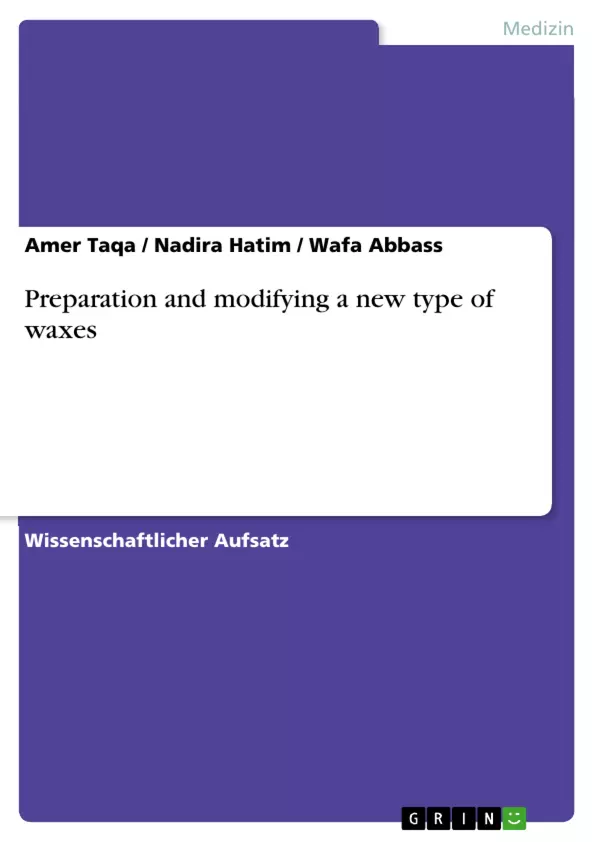To prepare and modify different wax compositions in order to find out the most suitable formula
that has almost the same properties of dental modeling wax used in dentistry. Materials and Methods:
Three groups of waxes (220 samples) with different compositions regarding its origin (Al–Dora
refinery waxes, natural bees wax–North of Iraq, and commercially available Iraqi waxes), additives
such as starch, sodium–carboxyl methylcellulose (Na–CMC), rosin, or nylon, and coloring agents were
prepared. The samples were tested for their melting range, 21 samples only had a melting range that
nearly coincides with that of the dental waxes such as Major and Cavex. Results: The resultant 21
samples were tested for their softening, trimming, penetration, residue materials and solubility. Only 4
samples showed properties that are closely similar to that of Major and Cavex wax. The results of
melting point ranged from 69–80oC. Softening test showed that the samples which contain nylon, Na–
CMC, or rosin were softened without adhering to the fingers. Trimming test showed that they were
trimmed easily and clearly. Penetration test showed that, some samples had the similar measurements
of Major and Cavex wax (0.6–0.9mm). Residue materials showed that all samples had no residue of
wax materials on acrylic teeth after wax elimination procedure. All the prepared waxes were soluble in
ether (acetone), and petroleum spirit (benzene). Conclusion: Six new modeling wax materials were
prepared according to ADA specification No.24. Three of new wax materials consist of nylon
(polystyrene 1.71–2.13%); the other two novel modeling waxes were fabricated by using additive
materials (Na–CMC and rosin).
Inhaltsverzeichnis
- ABSTRACT
- INTRODUCTION
- MATERIALS AND METHODS
- The materials used to fabricate new modeling wax materials were listed in Tables (1) and (2).
- A pilot study was done to fabricate a novel Iraqi modeling wax material.
- The samples were tested for their melting point.
- The resultant 21 samples were tested for their softening, trimming, penetration, residue materials and solubility.
- Group 1: The samples were fabricated from hard paraffin, soft paraffin, and bees wax (natural pure and impure-North of Iraq).
- Group 2: The samples were fabricated from commercially available wax materials, and pure bees wax.
- Group 3: The samples were fabricated from commercially available wax materials, pure beeswax, and additive materials either starch, or Na-CMC, or by adding 5-15% one brand of modeling wax (Major Prodtti Dentari SPA, Italy), and coloring agent.
- The new modeling waxes were subjected to the following tests:
- Melting point.
- Softening test.
- Trimming test.
- Penetration test.
- Residue material property.
- Solubility test.
- The samples were prepared by the following general methods:
- The mixing of wax was done by mixing different percentages of paraffin wax, and other additives in shaking water bath unit (Kavo GmbH, West Germany) (Figure 1) at 45-50°C for five minutes to obtain homogenous mixture liquid.
- Bees wax used in this study was a natural wax either pure or impure.
- Melting point: The mold used in this test was a cylinder of 2cm in diameter, and 2.5 cm in length to determine the melting point.
- Softening test: The samples were softened to 40-45 °C by the thermostatically controlled water bath unit (Kavo GmbH, West Germany) and tested by finger according to the ADA Specification No. 24 to determine the adherence of soft wax material.
- Trimming test: The samples were prepared with dimensions 10 mm diameter, and 6mm thickness (ADA Specification No. 24).(14) Trimming was done into 6µm cross sections by a microtome (Bright Co. Ltd, Huntingdon, England) at 23 + 2 °C.
- Penetration test: The samples were prepared with dimensions 10mm diameter, and 6 mm thickness (ADA Specification No. 24), and softened to 40-45 °C by the thermostatically controlled water bath unit (Kavo GmbH, West Germany), and tested by a standard Vicat apparatus (Baustoff Pruf Toni Technik) at 25 °C.
- Residue material: A silicone putty material (ORMASIL, Major Prodotti Dentari SPA, Italy) was used to prepare a special rubber mold with 5 mm diameter and 2.5 mm thickness that represents the usual thickness of denture base (ADA Specification No. 12).\" (14)
- Flasking was made in the conventional method: The flask was left on the bench for 2 hours at room temperature (23 ± 2 °C) after the final set of the plaster.
- Solubility test: This test was done to determine the weight of the samples before and after immersion.
- RESULTS AND DISCUSSION
Zielsetzung und Themenschwerpunkte
Die Forschung zielt darauf ab, eine neue Art von Wachs zu entwickeln und ihre Eigenschaften zu testen, um die geeignetste Formel für dentalen Modellierwachs im Vergleich zu kommerziellen Marken zu finden. Die Studie konzentriert sich auch auf die Entwicklung von Modellierwachs mit Zusatzstoffen.
- Herstellung und Modifizierung neuer Wachs-Zusammensetzungen
- Analyse der physikalischen Eigenschaften von Wachs
- Vergleich mit kommerziellen Marken von Dentalwachs
- Entwicklung neuer Wachs-Formeln mit Zusatzstoffen
- Bewertung der Eignung für Anwendungen in der Zahnprothetik
Zusammenfassung der Kapitel
- INTRODUCTION: Dieser Abschnitt erläutert die allgemeinen Eigenschaften von Wachs, einschließlich ihrer Einteilung in natürliche und synthetische Wachse. Er betont die Bedeutung von Schmelzpunkten und anderen thermischen Eigenschaften für die Verwendung von Wachs in der Zahnheilkunde.
- MATERIALS AND METHODS: Dieser Abschnitt beschreibt die Materialien, die zur Herstellung neuer Modellierwachse verwendet wurden, einschließlich der verwendeten Paraffin-, Bienenwachs- und Zusatzstoffe. Er erläutert das experimentelle Design und die durchgeführten Tests, wie Schmelzpunkt, Weichmacher, Trimmen, Eindringen, Rückstände und Löslichkeit.
- RESULTS AND DISCUSSION: Dieser Abschnitt präsentiert die Ergebnisse der durchgeführten Tests. Er analysiert die Schmelzpunkte, Weichmacher, Trimmbarkeit, Eindringtiefe, Rückstände und Löslichkeit der neuen Wachs-Formeln. Die Ergebnisse werden mit den Eigenschaften kommerzieller Marken von Modellierwachs verglichen, und die Bedeutung der verschiedenen Zusatzstoffe wird diskutiert.
Schlüsselwörter
Die wichtigsten Schlüsselwörter und Schwerpunktthemen dieser Arbeit sind Modellierwachs, Dentalwachs, Paraffinwachs, Bienenwachs, Zusatzstoffe, Schmelzpunkt, Weichmacher, Trimmbarkeit, Eindringen, Rückstände, Löslichkeit, Zahnprothetik, ADA-Spezifikation.
- Quote paper
- Amer Taqa (Author), Nadira Hatim (Author), Wafa Abbass (Author), 2006, Preparation and modifying a new type of waxes, Munich, GRIN Verlag, https://www.grin.com/document/207247



